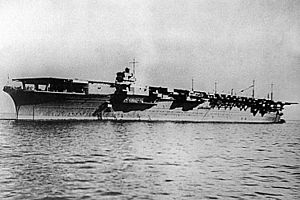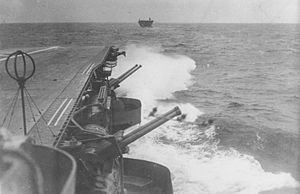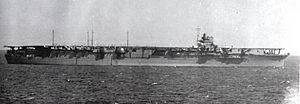Japanese aircraft carrier Zuikaku facts for kids

Zuikaku at Kobe on 25 September 1941 after commissioning
|
|
Quick facts for kids History |
|
|---|---|
| Name | Zuikaku |
| Builder | Kawasaki Shipyards |
| Laid down | 25 May 1938 |
| Launched | 27 November 1939 |
| Commissioned | 25 September 1941 |
| Stricken | 26 August 1945 |
| Fate | Sunk by air attack in the Battle of Leyte Gulf, 25 October 1944 |
| General characteristics (as built) | |
| Class and type | Shōkaku-class aircraft carrier |
| Displacement | 29,800 normal tons, 32,000 tons full load |
| Length | 257.5 m (844 ft 10 in) |
| Beam | 26 m (85 ft 4 in) |
| Draft | 8.9 m (29 ft 2 in) |
| Propulsion |
|
| Speed | 34.5 knots (63.9 km/h) |
| Range | 7,581 mi (6,588 nmi) at 18 kn (21 mph; 33 km/h) Fuel: 4100 tons |
| Complement | 1,660 |
| Armament |
|
| Aircraft carried |
|
Zuikaku (which means "Auspicious Crane" in Japanese) was a powerful aircraft carrier built for the Imperial Japanese Navy (IJN). She was the second and last ship of her type in the Shōkaku class. Zuikaku played a big role in the Pacific War, which was part of World War II. Her planes were involved in the famous attack on Pearl Harbor. She also fought in many other major naval battles. Sadly, Zuikaku was sunk during the Battle of Leyte Gulf in 1944. She was one of six carriers that attacked Pearl Harbor. Zuikaku was the very last of those six carriers to be sunk during the war.
Contents
Early Service and Pearl Harbor Attack
In 1941, Zuikaku was part of Carrier Division 5. Her captain was Yokokawa Ichibei. She sailed with her sister ship Shōkaku. On November 26, 1941, Zuikaku left Hitokappu Bay. She was part of the Kido Butai (Mobile Force). This force was heading to attack Pearl Harbor.
Her aircraft included 18 Zero fighters, 27 Aichi D3A dive bombers, and 27 Nakajima B5N torpedo bombers. On December 7, her planes launched two attacks. They targeted American military bases on Oahu island. In the first attack, dive bombers hit Wheeler Army Airfield. Fighters attacked the airbase at Kaneohe. In the second attack, torpedo bombers bombed Hickam Field.
Zuikakus planes also attacked Australian bases. These attacks happened at Rabaul on January 20, 1942. They also hit Lae in New Guinea on January 21. In April 1942, she joined the Indian Ocean raid. They attacked British naval bases in Ceylon. These bases were at Colombo and Trincomalee. With Shōkakus help, they sank the British aircraft carrier Hermes. They also sank the heavy cruisers Cornwall and Dorsetshire.
Battle of the Coral Sea
In May 1942, Zuikaku and Shōkaku were sent to support Operation Mo. This was an invasion of Port Moresby, New Guinea. American forces learned about this plan. They sent the carriers Yorktown and Lexington to stop the invasion.
On May 8, 1942, the main carrier forces met. This was during the Battle of the Coral Sea. Both sides launched many planes. Zuikaku was hidden by a rain squall. This helped her avoid being seen. However, Shōkaku was hit three times by bombs. She could not launch or recover her planes. In return, planes from both Japanese carriers hit Lexington. Lexington was later sunk by torpedoes from a friendly destroyer.
Zuikaku was not damaged in the battle. But she lost many planes and aircrew. She had to return to Japan for new planes and training. Because of this, neither Zuikaku nor Shōkaku could fight in the Battle of Midway in June 1942. All other carriers that attacked Pearl Harbor were sunk at Midway.
Battles for Guadalcanal
In August 1942, Captain Tameteru Notomo commanded Zuikaku. She was sent with the repaired Shōkaku and the light carrier Zuihō. Their mission was to fight the American forces in the Solomon Islands.
On August 24, 1942, during the Battle of the Eastern Solomons, Zuikaku's planes badly damaged the carrier Enterprise. For the next few months, Zuikaku was based at Truk.
On October 26, 1942, the Battle of the Santa Cruz Islands took place. Zuikaku's planes again damaged the repaired Enterprise. They also crippled Hornet. Hornet was later sunk by Japanese destroyers. However, Shōkaku and Zuihō were both heavily damaged by American air attacks. Zuikaku had to recover their surviving planes. Out of 110 planes launched by the three Japanese carriers, only 67 returned to Zuikaku. She then went back to Japan for training.

In February 1943, Zuikaku helped evacuate Japanese ground forces from Guadalcanal. In May, she was assigned to counter an American attack in the Aleutian Islands. But this operation was canceled after the Allies won on Attu on May 29, 1943. Later in 1943, Captain Kikuchi Tomozo commanded her. She was again based at Truk. She operated against U.S. forces in the Marshall Islands.
Battle of the Philippine Sea
In 1944, Zuikaku was based in Singapore. In June, she was part of Operation A-Go. This was an attempt to push back the Allied invasion of the Mariana Islands. On June 19, during the Battle of the Philippine Sea, two other Japanese carriers were sunk. Taihō and Shōkaku were sunk by American submarines.
Zuikaku was the only carrier left from Carrier Division One. She had to recover the few remaining planes from the division. On June 20, a bomb hit started a fire in her hangar. But Zuikaku's experienced crew managed to control the fire. She was able to escape on her own power. After this battle, Zuikaku was the only survivor of the six fleet carriers that had attacked Pearl Harbor.
Final Battle and Sinking
In October 1944, Zuikaku was the flagship of Admiral Jisaburo Ozawa's Northern Force. This force was a decoy in Operation Shō-Gō 1. This was the Japanese counterattack to the Allied landings on Leyte. On October 24, she launched planes with three light carriers. These were Zuihō, Chitose, and Chiyoda. They had only 108 planes in total. Their attack against the U.S. Third Fleet was not very effective. Many of these planes were shot down. Most of the surviving planes landed at Japanese land bases on Luzon.
However, some of her planes made kamikaze attacks. These attacks helped sink the light carrier Princeton. Other planes were sent to different carriers and air bases. They later helped sink the escort carrier St. Lo during the Battle off Samar. They also used the new kamikaze tactics.
The next day, during the Battle off Cape Engaño, Zuikaku launched her few remaining planes. They were used for air patrol or to join planes already on Luzon. Then, she came under heavy air attack. She was hit by seven torpedoes and nine bombs. Zuikaku began to list heavily to one side. Admiral Ozawa moved his flag to the light cruiser Ōyodo.
The order to abandon ship was given at 1:58 PM. The naval flag was lowered. Zuikaku rolled over and sank stern-first at 2:14 PM. Rear Admiral Kaizuka Takeo and 842 crew members died. However, 862 officers and men were rescued by the destroyers Wakatsuki and Kuwa. Before she was lost, Zuikaku was the last Japanese carrier that had attacked Pearl Harbor still afloat. She was also the only Japanese fleet carrier sunk by torpedoes launched from aircraft. Other fleet carriers were sunk by dive bombers or submarine torpedoes.
Gallery
-
A Nakajima B5N2 "Kate" taking off from Zuikaku to attack Pearl Harbor, 7 December 1941.
-
Zuikaku during the Battle off Cape Engaño, 25 October 1944.
See also
 In Spanish: Zuikaku para niños
In Spanish: Zuikaku para niños







